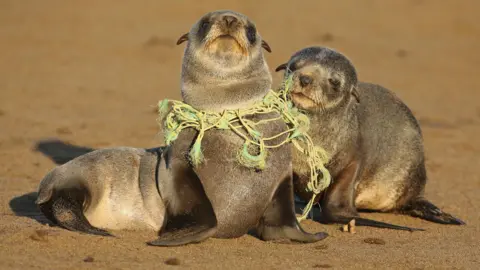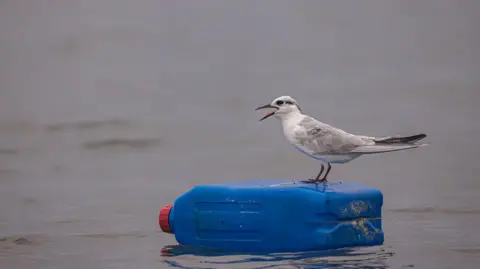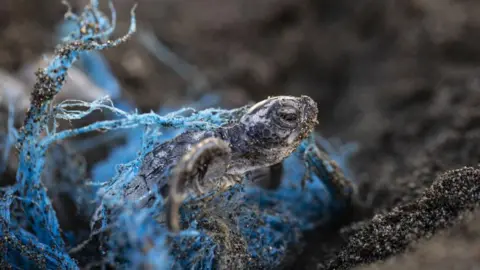Helen BriggsBBC environment correspondent

 Getty Images
Getty Images
A seal pup entangled in plastic on a beach
Scientists have analysed 10,000 marine animal autopsies to understand how plastic ingestion leads to death.
The study found seabirds face extreme risk after swallowing just 23 pieces of plastic, giving them a 90% chance of dying. Marine mammals reach similar danger at 29 pieces, while sea turtles need to ingest around 405 pieces to hit the same threshold.
The researchers were surprised by how little plastic can be dangerous - less than a soccer ball's worth of soft plastic by volume can be fatal to a dolphin, while a seabird might die from ingesting a few pieces of rubber smaller than the size of a pea.
They say the findings could help shape global efforts to protect wildlife.

 Getty Images
Getty Images
Plastic pollution poses a serious risk to sea birds from injury and poisoning
"It's a really important reminder that plastic pollution does pose an existential threat to ocean wildlife," said lead researcher, Dr Erin Murphy of the US-based environment group, Ocean Conservancy.
The analysis used autopsy data from seabirds, sea turtles, and marine mammals such as seals, sea lions, and dolphins, collected worldwide. Nearly half of the sea turtles studied, a third of the seabirds, and one in ten of the marine mammals had eaten plastic.
The researchers estimated the death risks from swallowing different sorts of plastic in each group of marine animals.
They found the type of plastic matters: rubber is most dangerous for seabirds; soft plastics and fishing debris pose the greatest risk to marine mammals; and both hard and soft plastics threaten turtles.

 Getty Images
Getty Images
A newborn green sea turtle struggles to escape a plastic net
The study examined only plastics found inside the stomachs of animals. It did not assess chemical impacts or entanglement, meaning the true scale of harm is likely to be higher.
Hundreds of marine species have been found with plastic in their bodies. Birds often swallow plastic fragments, and turtles mistake plastic bags for jellyfish. Until now, however, scientists lacked precise data on how much plastic is lethal for animals of different sizes.
Dr Murphy added: "To effectively address plastic pollution, the science is clear. We need to reduce the amount of plastic we produce, improve collection and recycling, and clean up what's already out there."
The research is published in Proceedings of the National Academy of Sciences.

 Movie
Movie 2 weeks ago
54
2 weeks ago
54 





![Presidents Day Weekend Car Sales [2021 Edition] Presidents Day Weekend Car Sales [2021 Edition]](https://www.findthebestcarprice.com/wp-content/uploads/Presidents-Day-Weekend-car-sales.jpg)




 English (United States)
English (United States)